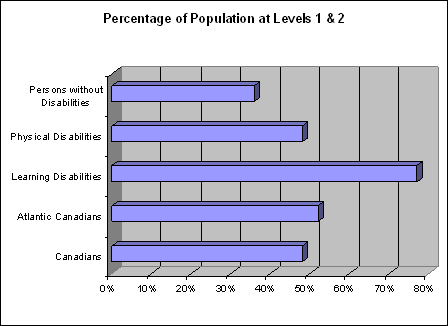The situation is somewhat more serious for persons with disabilities. A study entitled The Effects of Disability on Literacy Skills found that 77% of people with learning disabilities in Canada function below level 3 and 52% of those individuals function at level 1. The same study found that 48% of people with physical disabilities function below level 3 compared with 36% of people without disabilities.

The 1996 Census indicates that 5.1% or 12,490 individuals of the working
age population in HRM (ages 15 to 64) have an activity limitation (AL)
or long term disability (LTD) related to participation at school
and / or work. The difference in education between persons with an AL or
LTD versus those without is significant.
- 44% of persons with AL / LTD have not completed high school versus 24% of those who do not have an AL / LTD.
- On the other end of the spectrum, the data show that only 7% of those with AL / LTD have a university degree compared to 18% of those without AL / LTD.
In Nova Scotia, the unemployment rate for individuals with low levels of literacy is approximately 26% compared to 4% for individuals with high levels of literacy.2 In HRM, the unemployment rate for persons with AL or LTD is 6% higher than for those without – 14% and 8%, respectively.
2Literacy Nova Scotia, www.nald.ca/literacyns, Facts About Literacy 4